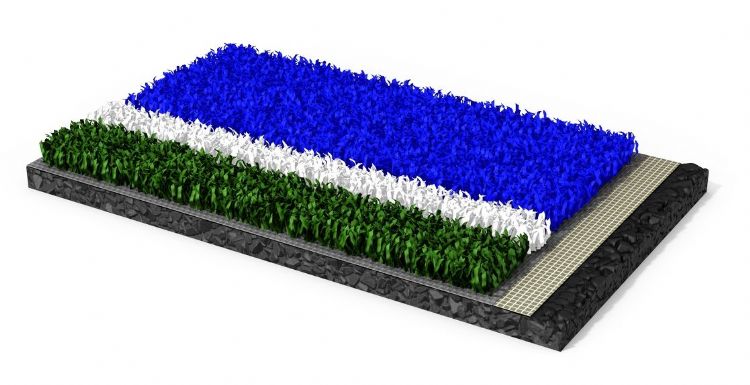Polytan has revealed the synthetic turf system for hockey that will be used during the 2020 Tokyo Olympics. The Poligras Tokyo GT requires up to 65% less water than surfaces used at previous Olympics. Most notably, yarn has been used that has been made of bio-based polyethylene.
The filaments are made from 60% regrowable raw materials, based on the renewable ‘I’m green polyethylene’ technology of Braskem. Braskem is the largest producer of thermoplastic resins in the Americas and the leading producer of biopolymers in the world. The company has a history in creating more environmental-friendly, intelligent and sustainable solutions through chemicals and plastics. Good examples are the stadium seats used at the Johan Cruyff Arena in Amsterdam, the Netherlands, which are made of Braskem biopolymers.
According to an official statement, plastic obtained from ethanol is derived from sugar cane. It is a vegetable raw material that, during its growth, captures carbon dioxide from the environment.
‘The reason why Polytan has chosen this raw material for its artificial turf production is that the carbon footprint of I’m green polyethylene has a positive impact compared to fossil polyethylene. For every kg of I’m green polyethylene used in Polytan’s hockey fields for the games in Tokyo in 2020, almost 5 kg of CO² will be saved. All this is being achieved without any compromise on the quality of the turf,’ Polytan Director Product Management Friedemann Söll explains. ‘With the development of the Poligras Tokyo GT, we have succeeded not only in making a hockey pitch more sustainable, but also in significantly improving its performance. Never before has a hockey turf been more environmentally friendly, never before has a turf allowed such a dynamic and precise hockey game. I am very proud of this.’
No major changes required
The company does not expect any restrictions in usage, durability and maintenance, routines for the Polytan Tokyo GT system. ‘Our experiences show, that the users can use the turf in the same way as they have been using their previous hockey turf surfaces, with the exception that they can have a good conscience of doing something positive for the world environment,’ Tobias Müller of Polytan said.
Müller points out recycling helps saving CO² emissions which has a positive impact in the overall calculation of the CO² savings of the product. Similar gains are achieved with the elastic layer that will be installed underneath the system.
‘The Polytan in-situ PolyBase GT e-layer also uses an environmental friendly technology during production. With this technology CO² which is generated in a side process, is used in the production of the PU binding agent necessary for the manufacture of the elastic layer. It thus it removes CO² from the environment. Furthermore, we will use ELT rubber granules which adds to this positive balance.’ ELT rubber is derived from recycling rubber.
The tuft bind and durability of the Polytan Tokyo GT turf system are credited for the reducing in water usage for the system. ‘A higher stitch density will prevent the water draining too quickly. The PreciTex design of the texturized filaments produces a very intensively curled filament and a good compact appearance right from the beginning, which holds the water spray better in the surface.’ All in all, the new system requires up to 65% less water than surfaces used at previous Olympics.
Step in the right direction
The International Hockey Federation (FIH) is happy with Polytan’s latest achievement.
‘FIH is delighted that this new turf technology will support Tokyo’s carbon-neutral vision and make a positive contribution to the Games. FIH has a strategic priority to improve hockey’s environmental footprint, which is why partnerships with progressive companies such as Polytan are crucial. We are pleased to note that the surface that will be used in Tokyo requires 2/3 less water than surfaces used at previous Olympic Games. FIH firmly believes that hockey can contribute to a more sustainable environment by making use of all the technological possibilities modern turf offers,’ FIH CEO Thierry Weil stated.
Reduced water consumption is important to FIH. Alastair Cox, FIH’s Facilities and Quality Programme Manager, noted during the ESTO conference in September last year that one watering of one hockey field consumes up to 18,000 litres. The international Water Poverty Threshold is set for approximately 20 litres per person per day.
Tobias Müller points out that, apart from changes in to the yarn and carpet, Polytan has also added its proven Polytan CoolPlus technology to the mix in an attempt to support FIH’s ambitions. ‘This can reduce the surface temperature considerably and avoids a too quick humidification of the water reservoir in the turf.’
With FIH currently on a drive to grow the fan-base for hockey, particularly in countries where water is a scarce commodity, synthetic turf systems that are less reliant on water will go a long way to improve the popularity of the sport. FIH’s ultimate goal is to have a field for the 2024 Paris Olympics that will not require any water at all to produce a safe and good quality field.
The partnership between Polytan and FIH will run until 2023. There is an option that the agreement will be extended with another two years.


